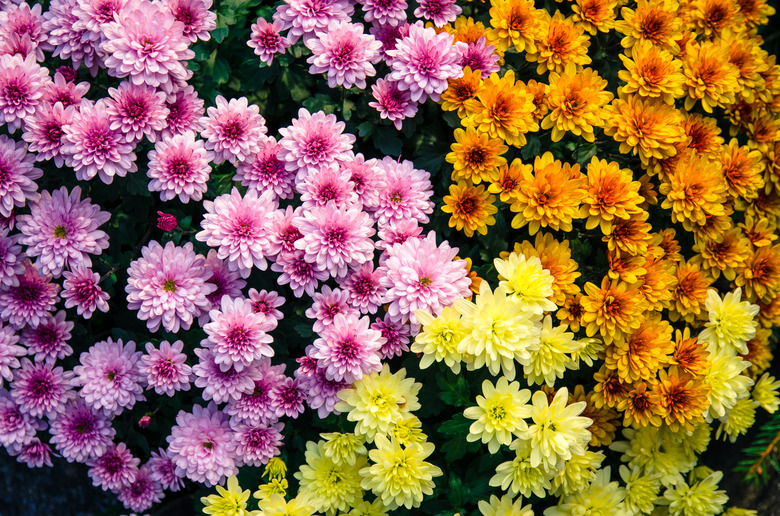How To Care For A Dying Mum House Plant
We may receive a commission on purchases made from links.
Some mums (Chrysanthemum spp., USDA zones 4-8) are frost-sensitive perennials that don't always survive beyond winter when grown outdoors. In contrast, a mum house plant will naturally cycle through periods of bloom, rest and growth, but it shouldn't automatically die after blooming. Several issues could cause your mum to start dying, but you may be able to nurse it back to health with proper diagnosis and treatment.
Correct Overwatering to Revive Mums
Correct Overwatering to Revive Mums
Too much water can kill plants by depriving the roots of oxygen. A drowning plant often displays many of the same signs of a water-starved plant, which can cause well-meaning gardeners to apply even more water and exacerbate the problem. If the soil is moist, allow the surface to dry out before watering it again.
If your mum is still growing in a plastic pot placed inside a decorative pot or foil pot cover, pull it out and ensure that water hasn't collected inside the decorative pot or cover. If it has, dump the standing water and get in the habit of dumping it regularly. Ensure the plastic pot has drainage holes as well, and use scissors to punch some out if needed.
Proper Growing Conditions for Mums
Proper Growing Conditions for Mums
A dying mum with dry leaves and faded flowers might be struggling to withstand too much sun, or it might not be getting enough sunlight for proper growth and development. Indoor mums do need bright light, but it should be filtered or indirect. Direct sunlight is too intense for indoor mums. This type of light will come from your south-facing windows, so place mums in front of north, west or east-facing windows instead.
Proper indoor air temperature and humidity levels will also keep your mums happy. They prefer cool temperatures versus hot temperatures. Aim to keep them in conditions around 60 to 70 degrees Fahrenheit, especially at night. Too much humidity and poor air circulation can also cause problems in mums, so consider running a fan to keep mum leaves dry and well ventilated.
Finally, make sure your mum plant has sufficient nutrients to support its growth and development. Apply a balanced NPK liquid fertilizer in late spring or early summer.
Winter Dormancy Is Normal
Winter Dormancy Is Normal
It's natural for many types of mums to go dormant in the winter, so don't panic if the plant loses its leaves during this season. Fertilizing, overwatering or pruning during this time can disrupt the plant's normal rest period. Although you won't see much activity in your mum during dormancy, its roots are still growing and storing food in preparation for spring. The only care it needs during this time is an occasional drink of water.
Addressing Pest Infestations
Addressing Pest Infestations
Healthy mums release a natural pesticide that keeps most insects away, but aphids in particular will literally suck the life out of a dying mum house plant. Closely inspect the underside of the leaves and stems to find these tiny insects. Aphids might be hard to detect because they're sometimes the same green color as the plant's leaves, although the more common chrysanthemum aphid typically is brown or black. They poke small holes into the plant's tissues and steal its water and nutrients, leaving behind tiny pinpricks that will turn yellow and brown.
If your mum's leaves or stems feel sticky, there are definitely aphids lurking around; this sticky substance is their excrement called "honeydew." You may see a trail of ants marching to and from the mum plant. They're harvesting the honeydew left by aphids and don't typically harm the mum plant directly.
Control active infestations and prevent new ones by saturating the mum with insecticidal soap. Alternatively, you can dunk the entire plant into a bucket of room-temperature soapy water to knock the aphids off its leaves. Rinse the plant in clean water and let it dry in a well-ventilated area.
